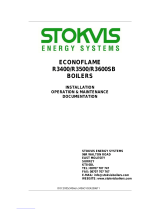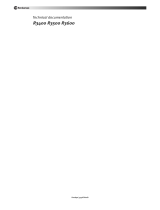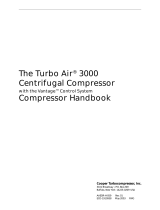Page is loading ...

STAINLESS STEEL HEAT EXCHANGERS
Installation, Operation &
Maintenance Guide
REG NO FM 38224
BS EN ISO 9001-2008

2
Rev A
Foreword
Dear Customer,
BOWMAN® has been manufacturing high quality stainless steel heat exchangers for over 20 years.
Your BOWMAN® Stockist/dealer will be happy to provide you with advice and practical assistance.
Please read these instructions fully and carefully.
Keep the Installation, Operation & Maintenance Guide for future reference to ensure the long lasting
performance from the stainless steel heat exchanger.
All rights reserved
E.J. Bowman (Birmingham) Ltd, reserve the right to change specification and technical alteration without prior notice.
No part of this guide may be reproduced or transmitted in any form or by any means including reproduction or recording without written
permission from E.J. Bowman (Birmingham) Ltd.

3
Rev A
H Y D R A U L I C O I L C O O L E R
Installation, Operation & Maintenance Guide
Contents
Foreword 2
1 . S A F E T Y
1.1 Hazards when handling the heat exchanger 4
1.2 Approved use 4
1.3 Potential hazards 4
2 . I N S T A L L A T I O N
2.1 Transport / storage 5
2.2 Fitting 5
2.3 Connecting the heat exchanger 6
3 . O P E R A T I O N 7
4 . C O M M I S S I O N I N G 7
5 . M A I N T E N A N C E / R E P A IR
5.1 Winter shut-down in areas exposed to frost 7
5.2 General maintenance 8
5.3 Cleaning 8
5.4 End cover bolt tightening sequence 8
6. PO T E N T I A L S E R V I C E I S S U E S
6.1 Tube failures 9
6.2 Fault finding 9
7. WA R R A N T Y 10
8 . S P A R E P A R T S 10
9 . C E M A R K I N G 10
E.J.Bowman (Birmingham) Ltd
Chester Street • Birmingham • B6 4AP • United Kingdom
Tel: +44 (0)121 359 5401 • Fax: +44 (0)121 359 7495
Email: info@ejbowman.co.uk • website: www.ejbowman.co.uk

Rev A
4
1 Safety
1.1 Hazards when handling the heat exchanger
BOWMAN® Heat exchangers are constructed to current practice and recognised safety standards.
Hazards may still arise from operation, such as:
- Injury of the operator or
- Third parties or
- Damage to the heat exchanger or
- Damage to property and equipment
Any person involved with the installation, commissioning, operation, maintenance or repair of the heat
exchanger must be:
- Physically and mentally capable of performing such work
- Appropriately qualified.
- Comply completely with the installation instructions
The heat exchanger must only be used for its intended purpose.
In the event of breakdowns which may compromise safety a suitably qualified person must always be
contacted.
1.2 Approved use
BOWMAN® Stainless Steel Heat Exchangers are only approved for the application stated at enquiry
stage. Any other use unless specified by BOWMAN® is not approved. BOWMAN® declines all
liability for damage associated or arising from such use.
The maximum permissible operating pressure must not exceed:
Oil (primary side) : 20 bar max.
Water (secondary side) : 20 bar max.
The maximum permissible operating temperature must not exceed:
Oil (primary side) : 200°C
Cooling Water (secondary side) : 120°C
1.3 Potential hazards
Ensure the maximum permissible operating pressure on the primary or secondary side of the heat
exchanger is not exceeded. The heat exchanger or surrounding equipment may be damaged.
NB: before the heat exchanger is disconnected it must be allowed to cool sufficiently and be
depressurized to prevent injury. The supply and returns to the heat exchanger should be isolated to
minimise fluid loss.

Rev A
5
2 Installation
2.1 Transport / storage
The heat exchanger must be fully drained down prior to transportation. Once drained and fully dry, the
heat exchanger must only be stored indoors within a non aggressive atmosphere. The connections
should be capped to avoid ingress of dirt and contaminants.
2.2 Fitting
Before fitting, the heat exchanger should be checked for visible signs of damage. The heat exchanger
should be positioned horizontally and should be connected in counterflow so that the fluids flow in
opposite directions, as shown below:
Multiple units can be connected in parallel:
Or in series:

Rev A
6
A filter with a maximum permeability of 2.5mm should be used prior to the inlet of each circuit of the
heat exchanger.
Nothing should be welded to any part of the oil cooler. Each unit comes complete with mounting
brackets.
2.3 Connecting the heat exchanger
Shut off all drainage valves in the flow and return pipes of the primary and secondary circuits.
When fitting the heat exchanger into the pipe work care must be taken to ensure that no debris has been
introduced into the primary or secondary circuit of the heat exchanger.
Unsupported lengths of pipework should be avoided so as not to subject the heat exchanger to
excessive loads.
Water side pipework diameter should not reduce to less than the connection size within a distance of
1m from the oil cooler.
Measures should be taken to isolate the oil cooler from excessive vibration.
Taper fittings are not recommended as these can damage the shell and end cover connections if over
tightened.
The correct length of fitting should be used as too long a fitting will damage the tubestack.
Pipework materials must be compatible with the heat exchanger materials.
For our oil coolers, the maximum permitted tube side water flow rates are as follows:
SB range 180 l/min. SE range 755 l/min.
SC range 295 l/min. SF range 1345 l/min.
SD range 540 l/min. SG range 2200 l/min.
No heat exchanger manufacturer can guarantee that his products will have an indefinite life and for
this reason, we suggest that the cooling system is designed to minimise any damage caused by a
leaking heat exchanger. This can be achieved as follows:
1. The primary circuit pressure should be higher than the secondary cooling water pressure, so
that in the event of a leak occurring, the primary circuit will not be contaminated.
2. When the primary circuit system is not being used, the heat exchangers should be isolated
from cooling water pressure.

Rev A
7
3 Operation
The heat exchanger should be pressurized on the primary circuit (shell) side such that it is at a higher
pressure than the secondary circuit (tube) side. This will ensure that if a leak occurs it will be detected by
a reduction in the level of the primary circuit fluid rather than it being contaminated. A differential
pressure of 2 bar would be sufficient.
It is essential that the following instructions are followed to prevent corrosion/erosion of the heat
exchanger:
a) Always maintain the water pH to within correct levels. The ideal water pH should be kept within
6.5 to 8.0.
b) Maximum fluid velocity through the heat exchanger of 4.0m/s. If in doubt contact BOWMAN®
for guidance.
c) Minimum water velocity of 1m/s should be used.
d) Chloride levels should be kept below 350 ppm
e) Ensure compliance with water quality and maximum permissible pressure requirements.
f) Air must be adequately vented from both circuits.
g) Stagnant water should not be allowed to accumulate in the heat exchanger. If it is not in use for any
period of time the water should be drained off.
4 Commissioning
Commissioning of the heat exchanger should not be undertaken until such time that this document has
been fully read and understood.
The primary and secondary circuits of the heat exchanger must be fully closed prior to
commissioning.
Adequate provision should be made to ensure that correct operating/service equipment along with
personal protection (PPE) in accordance with current standards/legislation is utilised prior to the
commencement of any working.
Cooling water should be introduced to the heat exchanger prior to the gradual introduction of hot
primary circuit fluid.
Both circuits should be vented initially and again when operating temperatures and pressures are
reached. The system should be checked for leaks.
5 Maintenance / Repair
5.1 Winter shutdown in areas exposed to frost
Care should be taken to prevent frost damage from a winter shutdown in conditions exposed to frost.
We recommend fully draining down the heat exchanger or removing the heat exchanger completely
from the installation throughout the duration of the shutdown period unless adequate heat load is
applied to the heat exchanger.

Rev A
8
5.2 General maintenance
While the unit is in operation, weekly inspection of the heat exchanger and its connections should be
maintained for leaks and externally visible damage.
BOWMAN® recommends that the tubestack should be cleaned and inspected annually and the o rings
should be renewed at this time.
Removal of the nuts and bolts around the periphery of each end cover will allow the end covers and
seals to be removed.
5.3 Cleaning
Any cleaning solutions used must be compatible with stainless steel. This should be confirmed with the
chemical’s supplier before use.
The chemical solution can be circulated through the heat exchanger or the unit can be submerged in a
container filled with cleaning fluid.
If necessary the fluid should be neutralized after cleaning and the unit should be flushed with fresh water
and dried.
Small diameter rods and brushes for tube cleaning are available from companies such as Easy Products
www.easyproductsltd.com
Replacement O rings should be fitted and the end cover bolts should be initially hand tightened, then
tightened in the sequence and to the torque figures below:
5.4 End cover bolt tightening sequence
End covers must be refitted in the correct orientation to ensure correct performance.
Oil Cooler
Series
Bolt Size
Torque (Nm)
Oil Cooler
Series
Bolt Size
Torque (Nm)
SB
M8
17.0
SE
M10
33.0
SC
M8
17.0
SF
M12
57.0
SD
M10
33.0
SG
M12
57.0

Rev A
9
6 Potential Service Issues
6.1 Tube failures
The majority of problems facing a heat exchanger are those of corrosion or erosion on the water side.
Two common types of failure are:
a) Impingement attack (or corrosion/erosion)
This is caused by water containing air bubbles flowing at excessive velocity through the tubes. The
impingement of rapidly moving water may lead to a breakdown of the protective passive film built up by
the tube thus allowing corrosion/erosion. This is worse with water containing sand or grit. The effect
of these conditions would be pockmarking and pinholing of the tubes.
b) Pitting
This problem is caused by very aggressive water in the tubes, especially in partially filled coolers where
the water is stagnant. High levels of chlorides in the water will also lead to pitting corrosion. Low water
flow rates can create a high temperature rise on the water side. Under these conditions deposits may
build or settle in the tube, allowing pitting corrosion to take place under the deposits.
This is only a brief introduction to corrosion problems. The subject is complex and the purpose of
these notes is to outline in very general terms what may occur under extreme conditions.
6.2 Fault finding
Symptoms
Possible Causes
Remedy
Increase in temperature
on shell side or excessive
pressure loss
Oil sludging, tube scaling or build
up of both resulting in an
insulating film covering the tubes
The complete heat exchanger
should be thoroughly cleaned
Pressure loss is as
expected, but the
temperature of the oil
rises
Film, scale or restrictions on the
inside of the tubes
The complete heat exchanger
should be thoroughly cleaned
Oil leaking into the
cooling water circuit or
vice versa
Split or perforated tubes
Tubes should be blocked with
hard wooden plugs as a
temporary measure & the
tubestack replaced asap
Inadequate performance
Flow rates too low
Unit connected in parallel flow
Check flow rates & increase if
necessary
Reconnect in counterflow as
per section 2.2

Rev A
10
7 Warranty
All BOWMAN® Stainless Steel Heat Exchangers are guaranteed against manufacturing and material
defects for a period of twelve months from the date of delivery.
BOWMAN® should be contacted immediately if a unit is received damaged. No attempt should be
made to repair a faulty unit as this will invalidate the warranty.
For full warranty terms, please see the BOWMAN® Conditions of Sale. A copy of which is available on
request or via download from the website:
www.ejbowman.co.uk
8 Spare Parts
A comprehensive stock of spare parts is always available.
Please contact our sales department for price and availability or nearest stockist.
9 CE Marking Documentation
Heat exchangers are covered by the Pressure Equipment Directive 97/23/EC which is mandatory for
all EU member states. This manual is part of the compliance and points out all essential safety
requirements to be observed.
BOWMAN® Stainless Steel Heat Exchangers fall within the Sound Engineering Practice category of the
Pressure Equipment Directive 97/23/EC and as such cannot be CE marked.

Rev A
11
Bowman products can also be found in the following industries: -
CHP Power Generation
Engine Test House Cooling
Marine Cooling
Swimming Pool Heating
Fishing Industry Cooling
The product range includes: -
Aquatic Heat Exchangers
Calorifiers
Exhaust Gas Heat Exchangers
Hydraulic Oil Coolers
Plate Type Heat Exchangers
Shell & Tube Oil Coolers
Swimming Pool Heat Exchangers
/








